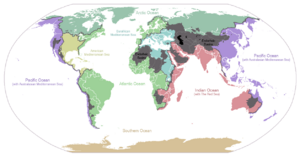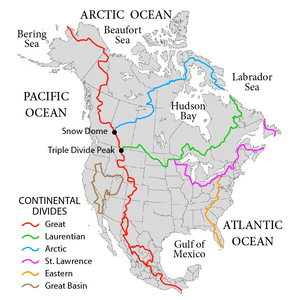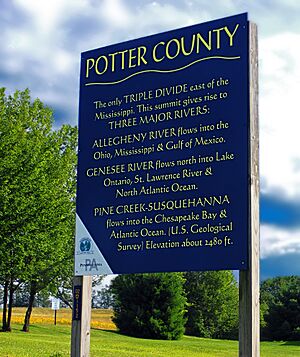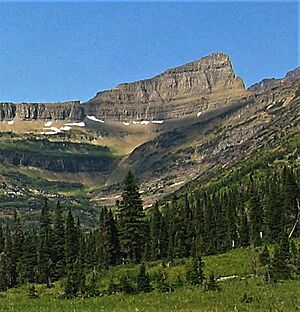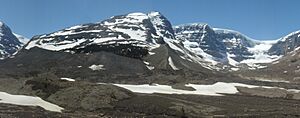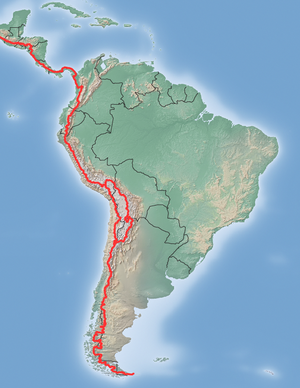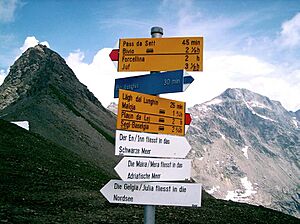Triple Divide facts for kids
Imagine a special spot on Earth where water can flow in three different directions! This spot is called a triple divide or triple watershed. It's a point where three large areas of land, called drainage basins, meet. Each basin collects water that eventually flows into a different river, lake, or even ocean.
Think of it like the top of a roof. Rain falling on one side goes one way, and rain on another side goes a different way. A triple divide is where three "roofs" meet, sending water to three separate places. These spots can be high up on mountains or just small changes in the ground.
Sometimes, the water flows underground in a different path than what you see on the surface. So, the exact underground triple divide might be a little different from the one you see on the land.
A hydrological apex is a very special triple divide. It's a place where water flows into three different oceans! There's only one known place like this on Earth: Triple Divide Peak in Montana, USA.
Contents
Triple Divides in North America
North America has several important triple divides. Four of them are where major continental divides meet. Water from these points flows into three different oceans, seas, or gulfs.
The most famous is Triple Divide Peak in Montana. It's called the "hydrological apex" because its water reaches the Pacific Ocean, the Atlantic Ocean (through the Gulf of Mexico), and the Arctic Ocean (through Hudson Bay).
Another important one is Snow Dome in British Columbia, Canada. Water from here also flows to the Pacific Ocean, the Arctic Ocean (through the Mackenzie River), and Hudson Bay.
Here are some other notable triple divides in North America:
- An unnamed hill in Potter County, Pennsylvania. Water flows to the Gulf of Mexico, the Atlantic Ocean, and the Saint Lawrence River (which leads to the Atlantic).
- The Hill of Three Waters, near Hibbing, Minnesota. Water goes to Hudson Bay, the Gulf of Mexico, and the Saint Lawrence River.
- A spot near Kissimmee, Florida, where water flows to Lake Okeechobee, the Atlantic Ocean, and the Gulf of Mexico.
- The Great Divide Basin in Wyoming has two triple points. Here, the Continental Divide of the Americas splits and then rejoins. Water can go to the Pacific Ocean, the Atlantic Ocean, or stay within the Great Divide Basin itself.
- Reeds Peak in New Mexico. Water flows to the Pacific Ocean, the Gulf of Mexico, or into the Guzmán Basin.
- Three Waters Mountain in Wyoming. Water from here can reach the Gulf of California (Pacific), the Pacific Ocean (via the Columbia River), or the Gulf of Mexico.
- Commissary Ridge in Wyoming. Water flows to the Gulf of California, the Pacific Ocean, or the Great Basin.
Some other points are also considered triple divides because they separate basins of large rivers. For example, Headwaters Hill in Colorado sends water to the Arkansas River, Rio Grande River, and Colorado River. However, both the Arkansas and Rio Grande rivers eventually flow into the Gulf of Mexico, making it less of a "continental" triple divide.
The highest important triple divide in the lower 48 states of the US is a sub-peak of Mount Wallace in California. It's called Crumbly Spire. Water from here flows to Tulare Lake, Owens Lake, and the Pacific Ocean.
Another example is Young Lick Knob in Georgia. Water flows to the Savannah River, Apalachicola River, and the Mississippi River.
Triple Divides in South America
South America also has places where the main water divide splits, creating triple points.
Triple Divides in Europe
Europe has several interesting triple divides:
- Lunghin Pass in Piz Lunghin, Switzerland. Water flows to the North Sea (via the Rhine River), the Black Sea (via the Danube River), and the Mediterranean Sea (via the Po River).
- Trójmorski Wierch in the Sudetes mountains, on the border of the Czech Republic and Poland. Water goes to the North Sea, the Black Sea, and the Baltic Sea.
- An unnamed point near Langres, France. Water flows to the North Sea, the English Channel, and the Mediterranean Sea.
- Witenwasserenstock in Switzerland. Water flows to the North Sea, the Adriatic Sea, and the Mediterranean Sea.
Triple Divides in Africa
There's an unnamed hill on the border between the Central African Republic and South Sudan. Water from this point flows to the Atlantic Ocean (via the Congo River), the Mediterranean Sea (via the Nile River), or into Lake Chad, which is a lake that doesn't flow to the ocean. This is a very important triple divide because it connects three of the world's largest river basins.
Triple Divides in Australia
Australia has two main triple divides, both in Queensland. They are named after explorers Thomas Mitchell and Edmund Kennedy.
- Mitchell Junction in North Queensland. Water can flow to the Pacific Ocean, the Indian Ocean (via the Gulf of Carpentaria), or to Lake Eyre, which is an inland lake.
- Kennedy Junction in Central Queensland. Water can flow to the Pacific Ocean, the Southern Ocean (via the Murray/Darling River), or to Lake Eyre.
Triple Divides in Asia
Asia has many areas where rivers don't reach the ocean. These are called endorheic basins. There's a point in southern China where the Pacific Ocean, Indian Ocean, and an endorheic basin meet. Another point in northern China connects the Pacific Ocean, an endorheic basin, and the Arctic Ocean.
Triple Divides in Antarctica
Antarctica is completely surrounded by the Southern Ocean. Because of this, it doesn't have any true triple divides where water flows to different oceans.
However, in the past, people sometimes defined the oceans differently, saying the Atlantic, Pacific, and Indian Oceans touched Antarctica. If you use that old idea, and imagine that the ice sheet acts like a watershed, then Dome Argus could be seen as a triple divide.
See also


